Kepi
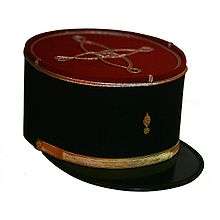
The kepi (English: /ˈkɛpiː/ or /ˈkeɪpiː/) is a cap with a flat circular top and a peak, or visor. Etymologically, the term is a loanword of the French képi, itself a re-spelled version of the Alemannic Käppi: a diminutive form of Kappe, meaning "cap". In Europe, this headgear is most commonly associated with French military and police uniforms, though versions of it were widely worn by other armies during the late 19th and early 20th centuries. In North America, it is usually associated with the American Civil War, as it was worn by soldiers on both sides of the conflict.

French army – history
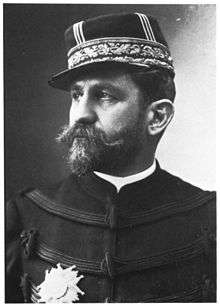
The kepi was formerly the most common headgear in the French Army. Its predecessor originally appeared during the 1830s, in the course of the initial stages of the occupation of Algeria, as a series of various lightweight cane-framed cloth undress caps called casquette d'Afrique. These were intended as alternatives to the heavier, cloth-covered leather French Army shako.[1] As a light and comfortable headdress, it was adopted by the metropolitan (French mainland) infantry regiments for service and daily wear, with the less practical shako being relegated to parade use. In 1852, a new soft cloth cap was introduced for campaign and off-duty. Called bonnet de police à visière, this was the first proper model of the kepi. The visor was generally squarish in shape and oversized and was referred to as bec de canard (duck bill). This kepi had no chinstrap (jugulaire). Subsequent designs reduced the size of the cap and introduced chinstraps and buttons. The kepi became well known outside France during the Crimean War and was subsequently adopted in various forms by a number of other armies (including the U.S. and Russian) during the 1860s and 1870s.
In 1870 when troops were mobilized for the Franco-Prussian War large numbers of French soldiers either refused to wear the issued shakos or threw them away. Emperor Napoléon III abolished the infantry shako for active service and replaced it with the kepi on 30 July 1870.[2]
In 1876, a new model appeared with a rounded visor, as the squared visor drooped when wet and curled when drying. The model used in World War I was the 1886 pattern, which was a fuller shape incorporating air vents.
By 1900, the kepi had become the standard headdress of most French army units and (along with the red trousers of the period 1829–1914) a symbol of the French soldier. It appeared in full dress (with inner stiffening and ornamental plume or ball ornament) and service versions. Officers' ranks were shown by gold or silver braiding on the kepi. The different branches were distinguished by the colours of the cap – see the table. Cavalry normally wore shakos or plumed helmets, reserving red kepis with light or dark blue bands for wear in barracks. General officers wore (and continue to wear for ceremonial purposes) kepis with gold oak leaves embroidered around the band.
In 1914 most French soldiers wore their kepis to war. The highly visible colours were hidden by a medium blue-grey cover, following the example of the Foreign Legion and other North African units who had long worn their kepis with white (or later khaki) covers in the field. With the adoption of "horizon blue" (light blue-grey) uniforms and steel Adrian helmets in 1915 to replace the conspicuous peace time uniforms worn during the early months of war, the kepi was generally replaced by folding forage caps. Officers, however, still wore kepis behind the lines.
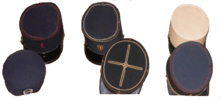
Following the war the kepi was gradually reintroduced in the peacetime French Army, but was never adopted for wear in the Navy or Air Force. The Foreign Legion resumed wearing it in 1926;[3] initially in red and blue and then in 1939 with white covers on all occasions. The bulk of the French army readopted the kepi in the various traditional branch colours for off-duty wear during the 1930s. It had now become a straight sided and higher headdress than the traditional soft cap. This made it unsuitable for war time wear, and after 1940 it was seldom worn except by officers. An exception was the Foreign Legion who, previously just one of many units that wore the kepi, now adopted it in its white version as a symbol.
Modern French usage
Army
The decision following the 1991 Gulf War to end conscription in France and to rely on voluntary enlistment has led to the readoption of various traditional items for dress wear. This has included the reappearance in the army of the kepi which is now worn by all ranks in the majority of units, on appropriate occasions.Within the army, particularly notable are the kepis of the French Foreign Legion, whose members are sometimes called Képis blancs (white kepis), because of the unit's regulation white headgear. Former cavalry units wear light blue kepis with red tops and silver braid (for officers) and insignia. Other colours include all dark blue with red piping (for artillery units), dark blue with red tops (line infantry) and crimson with red tops (medical). The "dark blue" of officers' kepis is actually very similar to black.
| Corps | Colour of band | Colour of crown | Braid and insignia |
|---|---|---|---|
| Infantry, Zouaves (now disbanded) & Chasseurs-Paratroopers | dark blue | red | gold |
| Tirailleurs | light blue | red | gold |
| Shock Parachuters, Shock Commandos, Supply & Quartermaster’s Corps | dark blue | red | silver |
| Cuirassiers, Dragoons, Hussars, Tanks & Matériel | light blue | red | silver |
| Infantry Chasseurs | dark blue | dark blue | silver French horn |
| Spahis | light blue | red | gold |
| Artillery, Marines & Transmissions | dark blue | dark blue | gold |
| Engineers & Bands | black | black | gold |
| Légion étrangère | white (privates, corporals and chief corporals) black (chief corporals with more than 15 years service, NCOs and officers) | white red | gold (infantry) silver (cavalry) |
| Army Aviation | blue | blue | gold |
| Medical Corps (now all-services combined corps with naval style caps) | crimson | red | gold |
| Pharmaceutical Corps | green | red | gold |
| Veterinarian Corps | purple | red | silver |
| Dental Corps | brown | red | gold |
| Waters and Forest (chasseurs forestiers) | dark green (vert finance) | dark green (vert finance | silver French horn |
Other organizations
The French National Police discarded their dark blue kepis in 1982, adopting a low peaked cap. The reason given was that the rigid kepi, while smart and distinctive, was inconvenient for ordinary use and too high to be comfortably worn in vehicles.
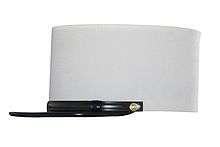
French customs officers (douaniers) and the Gendarmerie still wear kepis for ceremonial duty. Customs officers wear a baseball style cap for ordinary duties (since 1994 with many variations) while the Gendarmerie introduced a "soft kepi" in the early 2000s.
North American usage

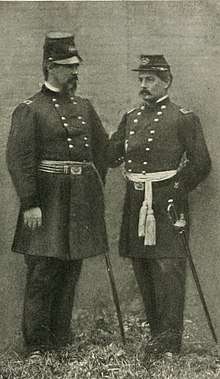
In the United States, the kepi is most often associated with the American Civil War era, and continued into the Indian Wars. Union Officers were generally issued kepis for fatigue use. A close copy of the contemporary French kepi, it had a sunken top and squared visor. It was often called a "McClellan cap", after the Union commander of the Army of the Potomac, G.B. McClellan. For field officers, the caps were often decorated in a French-influenced style, with a dark velvet band around the base and black silk braiding on the crown. The kepi was also popular with various state units and as privately purchased headgear; e.g., it was standard issue in 1861 for New York infantry regiments.
The kepi is not to be confused with the model 1858 forage cap, sometimes called a "bummer cap" or McDowell cap, which evolved directly from the shako used by the regular army earlier in the 1850s (see the design of the crown, chinstrap, brim, and buckle). Essentially, the forage cap, described by some troops as "shapeless as a feedbag", was a less-expensive and more comfortable version of the earlier shako with the stiffening removed. The forage cap became the most common form of cap worn by U.S. regulars and volunteers during the American Civil War, though it is most commonly associated with the eastern theater of the war, since western troops generally preferred broad-brimmed felt hats (see photos of Sherman's army parading through Washington D.C. at war's end). The forage cap appears in films such as Gettysburg, Gods and Generals, and Glory. Some Union units wore coloured variants, as some illustrative examples show:
- 14th New York (from Brooklyn) – dark blue base, red sides, dark blue top, red circular insert
- 12th New York – red base, grey sides, red top, white piping and later – dark blue base, light blue top and sides, white piping
- 11th Indiana – all red cap
- United States Cavalry - Dark blue with a yellow base.
- U.S. Sharpshooters – dark green (also used forage caps)
While some Confederate troops wore the forage cap (Confederate General Thomas J. "Stonewall" Jackson wore the plain dark blue round-visored forage cap from his days as an instructor at the Virginia Military Institute), Confederate uniform regulations specified a French-style kepi. These were to be trimmed as follows:
- Confederate Regulars:
The regulations were often ignored because of the scarcity of materials and the need for rapid production. The average Confederate kepi usually was a simple gray or butternut cap made of wool or jean wool. To save leather for shoes and accoutrements, by mid-war Confederate kepi brims often were made of tarred cloth; chinstraps were sometimes omitted. Many Confederate units wore unique versions of the kepi. These included:
- Winchester Zouave Cadets (of South Carolina) – all red
- Kentucky Brigade cavalry – all yellow
- Alexandria Rifles (of Virginia) – dark green
After the war the U.S. Army issued a series of kepi undress caps, characterised by their increasing smartness and decreasing practicality. The last model was issued in 1896. When the United States introduced a revised blue dress uniform in 1902, the kepi was discontinued in favour of a conventional visor cap with wide top and a steep visor.
The US Army's and Air Force's current patrol cap, the standard covers in utility uniforms (the ACU and ABU, respectively), is a variation of the flat-topped, visored kepi. Its modern lineage can be traced to World War II, and during the Cold War period was "blocked" with heavy starching and ironing (referred to as a "Ridgeway cap"). It was replaced with a baseball-style cap during the Vietnam War. The present-day patrol cap was introduced in the 1980s with the transition to the M81 BDU uniforms, and was retained when the Army adopted the UCP digital-pattern camouflage uniforms in 2005, and Air Force's adoption of the ABU in 2007.
South America
During the Paraguayan War between Brazil, Argentina, and Uruguay versus Paraguay, Brazilian, Argentine and Uruguayan troops and officers primarily wore kepis (although many Brazilian troops wore brimmed hats, and Uruguayan and Argentine light infantry wore shakos). The Paraguayans mostly wore leather shakos, but senior officers were given kepis. Leather kepis were however issued as a forage cap to Paraguayan troops, and because of poor supply standards, were often seen in combat.
With the exception noted below, the Chilean Army no longer wears kepis but during the War of the Pacific it was part of the standard army uniform. Similarly the kepi is no longer worn by the modern Peruvian armed forces and police but was part of the uniforms worn during the 19th and early 20th centuries.
Today the following ceremonial units in both countries still use the kepi:
- in Chile the 4th Company of the 7th Reinforced Regiment "Chacabuco" and the 1st Historical Company of the 4th Mechanized Infantry Brigade "Rancagua":
- in Peru the Fanning Marine Company of the Peruvian Navy; and the National Police of Peru's Guards Inspector Mariano Santos Company. Both retain the War of the Pacific uniforms respectively of the Peruvian Navy and the Civil Guards of Peru. A Peruvian Army company has recently adopted the kepi and white uniforms worn by the 2nd Infantry Battalion "Zepita" during the War of the Pacific for public parades.
Bolivia's 1st Infantry Regiment "Colorados" and the 2nd and 3rd Infantry Regiments of the Bolivian Army also wear the kepi as part of their full dress uniforms on major ceremonial occasions.
The Argentine National Gendarmerie (Gendarmería Nacional Argentina; GNA) members wears a green kepi as part of fatigue and full dress uniforms.

Military/police usage elsewhere
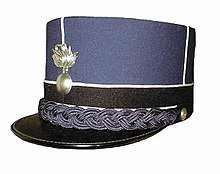
The practical nature and relative cheapness of the kepi made it a popular military headdress from the mid-nineteenth century on. Many Latin American armies wore kepis in the late 19th and early 20th centuries which were close copies of the French model. Other armies that favoured kepis during the final period of colourful uniforms that ended with World War I included the Danish, Portuguese, Dutch, Italian (officers only), and Romanian armies. Even the Japanese Army adopted French-style kepis for senior officers in full dress, as well as for their Gendarmerie units and military bands. Significantly such historic opponents of France as Germany and Britain, avoided the use of kepis, with only a few short-lived exceptions, such as for service in India during the 1850s-60s. During this time the Albert Shako was preferred. This may have been for practical rather than patriotic reasons, as the distinctive profile of the kepi would be likely to lead to confusion in battle.
Belgium
Influenced by France's adoption of the kepi, Belgium introduced it in 1845 as a forage cap for infantry other ranks.[4] This headdress was worn until 1868 when a new model without a vizor was adopted.[5] Officers of infantry and cavalry regiments wore their own version of the kepi from 1859 until the First World War.[6] It was modified several times over the decades, the last version being the 1900/1910 model. By that time it had evolved into a comparatively tall cylinder with the national emblem at the front and a cross-shaped Austrian knot on the crown. The wearer's rank was indicated by a system of horizontal and vertical bands of gold or silver braid. The kepi was also worn by officers of the General Staff.[7][8]
In September 1914 the wide range of peacetime headdresses (shakos, busbies, "Corsican" caps, czapkas and bearskins) still being worn by the Belgian Army, were replaced by the universal "Yser" kepi. This consisted of a dark blue or green soft cap with folding double flaps.[9] With the adoption of a British-style khaki uniform from 1915, the kepi was abandoned in favour of the peaked cap for all ranks,[10] with the exception of the paramilitary Gendarmerie, who continued to wear the kepi as part of their parade dress until the 1960s.
Denmark
Used by all soldiers of the Danish army until World War II, it is now only retained as part of the full dress uniforms for officers.[11]
Greece
Until the early 20th century the Greek Army wore dark blue or green (the latter for cavalry) kepis, and continued the same style of headress in khaki when field uniforms of that colour were introduced in 1910. Officer cadets and NCO trainees still wear kepis as part of the full dress uniforms of their respective military academies.
India
In India, during the French colonial rule of Pondicherry, Yanam, Karaikal and Mahé, Kepis were worn by two kinds of policemen, the Armed and the Indigenous, differentiated by the colour of the kepis they wore. While the law and order forces wore bright red caps, the armed constabulary was conspicuous by its blue kepis. After Indian Independence, the former French colonial territory was integrated into the Union Territory of Puducherry and the bright red kepi continues to be the headgear of the constabulary — both for the local and the armed police signifying the cultural and administrative legacies left by the former colonialists.[12]
Latvia
In modern ceremonial dress the Latvian National Armed Forces Staff Battalion and Staff Orchestra both wear backward sloping kepis of the style worn by the Belgian Army immediately prior to World War I.
Luxembourg
Kepis with a slightly higher back were formerly worn by the Luxembourg Army until 1945. Since World War II they were replaced by British Army-style peak caps.
The same kepis with higher back were also worn by the former Grand Ducal Gendarmerie in a blue version corresponding to the colour of their uniforms.
The kepi is still used by the newly created Grand Ducal Police which replaced the Gendarmerie and the local police forces in 2000.
Nazi Germany
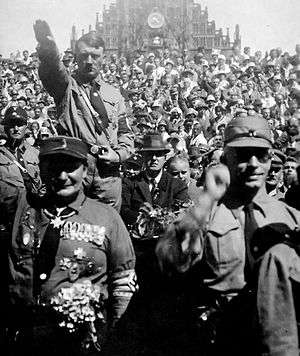
The brown stiff képi (Schaftmütze) of Hitler's Brownshirt Stormtroopers (SA, Sturmabteilung) and its black version initially worn by the members of the SS (before it was replaced by a peaked cap) were derived from surplus Austrian equipment.[13]
Northern Ireland
A form of kepi is worn by female officers in the modern Police Service of Northern Ireland.
Norway
The Norwegian armed forces used kepis until World War II and still retain them as part of the full dress of officer cadets.
Spain
In Spain, a version of the kepi (actually a low shako), the ros, is used by the Guardia Real (Royal Guard) and the Regimiento de Infantería Inmemorial del Rey for ceremonial functions. The Spanish 1887 regulation kepi or Teresiana was made of black oilcloth with a tortoise shell visor. A plainer form of kepi was retained by the Civil Guard as its non-ceremonial headdress for normal police duties, until it was abolished under the 2011 revised regulations and replaced by a baseball cap.
Sweden
In Sweden, the kepi has been used with several uniform types. The most common was the grey kepi worn as part of the M1923 field uniform and the dark blue kepi worn as part of the uniform types m/1886 and m/1895, and still in use by the Life Guards.
Switzerland
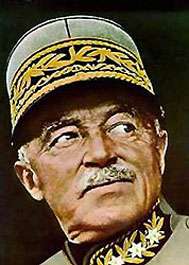
In Switzerland, the kepi was worn as a part of the dress uniforms of senior NCOs (Sergeant major and above) and officers (with additional rank insignia) until the 1995 army reform (Swiss Armed Forces). Since then, it is only worn by senior staff officers (Brigadier general and higher).
 Brigadier General
Brigadier General Major General
Major General Lieutenant General
Lieutenant General General
General
Non-military use
.jpg)
Kepis also found their way into the uniforms of numerous railway and streetcar operators in the United States. From there it was adopted by other public transport operators around the world, including the examples given below:
- in Brisbane, Australia drivers and conductors continued to wear distinctive white kepis with black visors until 1961. Brisbane bus inspectors continued to wear black kepis with decorative braid until the introduction of a blue version in 1987. Brisbane Transport finally replaced inspector's kepis in 1995, although as of 2006 they could still be worn at official functions.
- Belgian Railways conductors (but not train drivers or other personnel) wear a kepi as part of their daily uniform.
- a form of kepi modeled on the Austrian ski-cap, was the standard headgear of uniformed British Rail male employees from the mid-1960s to the mid-1980s.
- A round peak-less cap with an outline resemblance to a kepi is also worn by traditional student fraternities, also called Studentenverbindung, in Germany, Austria, Switzerland and Belgium. They come in different varieties and are very colorful in appearance.
- In the United States, the Nation of Islam's security/executive protection force, the Fruit of Islam, also wears a dark blue version of the kepi.
Gallery
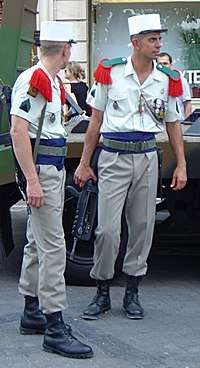 Foreign legionnaires
Foreign legionnaires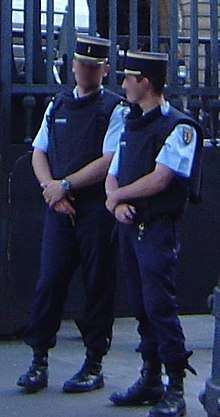 French gendarmes of the Gendarmerie Mobile
French gendarmes of the Gendarmerie Mobile Contemporary French Army képi
Contemporary French Army képi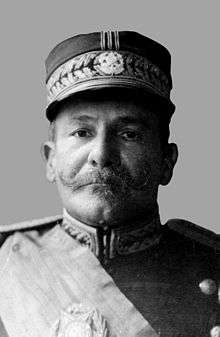 Marshal Hermes da Fonseca, former President of Brazil, wearing a kepi, c.1910
Marshal Hermes da Fonseca, former President of Brazil, wearing a kepi, c.1910 Royal Swedish Life Guard dragoons in 2015
Royal Swedish Life Guard dragoons in 2015
See also
| Wikisource has the text of the 1905 New International Encyclopedia article Képi. |
References
| Wikimedia Commons has media related to Kepis. |
- ↑ Mollo, John. Military Fashion. pp. 159–162. ISBN 0-214-65349-8.
- ↑ p. 77 Wawro, Geoffrey The Franco-Prussian War: The German Conquest of France in 1870-1871 Cambridge University Press, 21 Feb 2005
- ↑ Coune, Frederick. Les Coiffures Militaires Francaises 1870-2000. p. 65. ISBN 978-2-35250-241-8.
- ↑ Guy Derie, page 40 "Les Soldates de Leopold Ier et Leopold II", D1986/0197/03, Paul Legrain Bruxelles 1986
- ↑ Guy Derie, page 45 "Les Soldates de Leopold Ier et Leopold II", D1986/0197/03, Paul Legrain Bruxelles 1986
- ↑ War Office, General Staff. Handbook of the Belgian Army 1914. p. 18. ISBN 978-1-78331-094-4.
- ↑ Lierneux, Pierre. October 2003. "L'officier d'infanterie belge en 1914 - 1918" [The Belgian Infantry Officer 1914 - 1918] Militaria Magazine No. 219, pp 34 - 37
- ↑ 1900/1910 kepi of Lieutenant General https://www.photo.rmn.fr/archive/07-520253-2C6NU0CGSP96.html
- ↑ Pawly, R. The Belgian Army in World War I. pp. 41–42. ISBN 978-1-84603-448-0.
- ↑ Mollo, Andrew. Army Uniforms of World War I. p. 106. ISBN 0-668-04468-3.
- ↑ Army Operational Command (September 2012). "Uniform Regulations for the Army" (PDF). parawings.com (in Danish). p. 601. Archived from the original (PDF) on 19 October 2016. Retrieved 7 November 2016.
- ↑ "POLICE HISTORY". Government of Puducherry. Retrieved 2016-01-02.
- ↑ Toland, John (1976). Adolf Hitler. New York: Doubleday & Company. ISBN 0-385-03724-4.